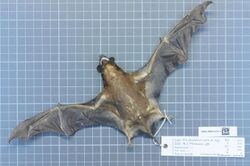Biology:Cynomops
From HandWiki
Short description: Genus of bats
| Cynomops | |
|---|---|

| |
| Preserved C. abrasus specimen in the Naturalis Biodiversity Center | |
| Scientific classification | |
| Domain: | Eukaryota |
| Kingdom: | Animalia |
| Phylum: | Chordata |
| Class: | Mammalia |
| Order: | Chiroptera |
| Family: | Molossidae |
| Genus: | Cynomops Thomas, 1920 |
| Type species | |
| Molossus cerastes Thomas, 1901
| |
| Species | |
|
See text | |
Cynomops is a genus of Central and South American dog-faced bats in the family Molossidae.[1] It has sometimes been considered a subgenus of Molossops. It contains the following species:
- Cinnamon dog-faced bat (C. abrasus)
- Freeman's dog-faced bat (C. freemani)
- Greenhall's dog-faced bat (C. greenhalli)
- Cynomops kuizha[2]
- Cynomops mastivus (C. mastivus)
- Mexican dog-faced bat (C. mexicanus)
- Miller’s dog-faced bat (C. milleri)
- Para dog-faced bat (C. paranus)
- Southern dog-faced bat (C. planirostris)
- Waorani dog-faced bat (C. tonkigui)
Phylogeny
| ||||||||||||||||||||||||||||||||||||||||||||||||
| Phylogeny of Cynomops[3][4] |
References
- ↑ Simmons, N.B. (2005). "Order Chiroptera". in Wilson, D.E.; Reeder, D.M. Mammal Species of the World: A Taxonomic and Geographic Reference (3rd ed.). Johns Hopkins University Press. pp. 436-437. ISBN 978-0-8018-8221-0. OCLC 62265494. http://www.departments.bucknell.edu/biology/resources/msw3/browse.asp?id=13801602.
- ↑ Pskhun (2021-04-18). "Species New to Science: [Mammalogy • 2021 Cynomops kuizha • A New Species of Cynomops (Chiroptera: Molossidae) from the northwestern Slope of the Andes"]. http://novataxa.blogspot.com/2021/04/cynomops-kuizha.html.
- ↑ Peters, Sandra L; Lim, Burton K; Engstrom, Mark D (2002). "Systematics of Dog-Faced Bats (Cynomops) Based on Molecular and Morphometric Data". Journal of Mammalogy 83 (4): 1097. doi:10.1644/1545-1542(2002)083<1097:SODFBC>2.0.CO;2.
- ↑ Moras, Ligiane M.; Gregorin, Renato; Sattler, Thomas; Tavares, Valéria da C. (2018). "Uncovering the diversity of dog-faced bats of the genus Cynomops (Chiroptera: Molossidae), with the redescription of C. milleri and the description of two new species". Mammalian Biology 89 (1): 37–51. doi:10.1016/j.mambio.2017.12.005.
Wikidata ☰ Q2729634 entry
 |


